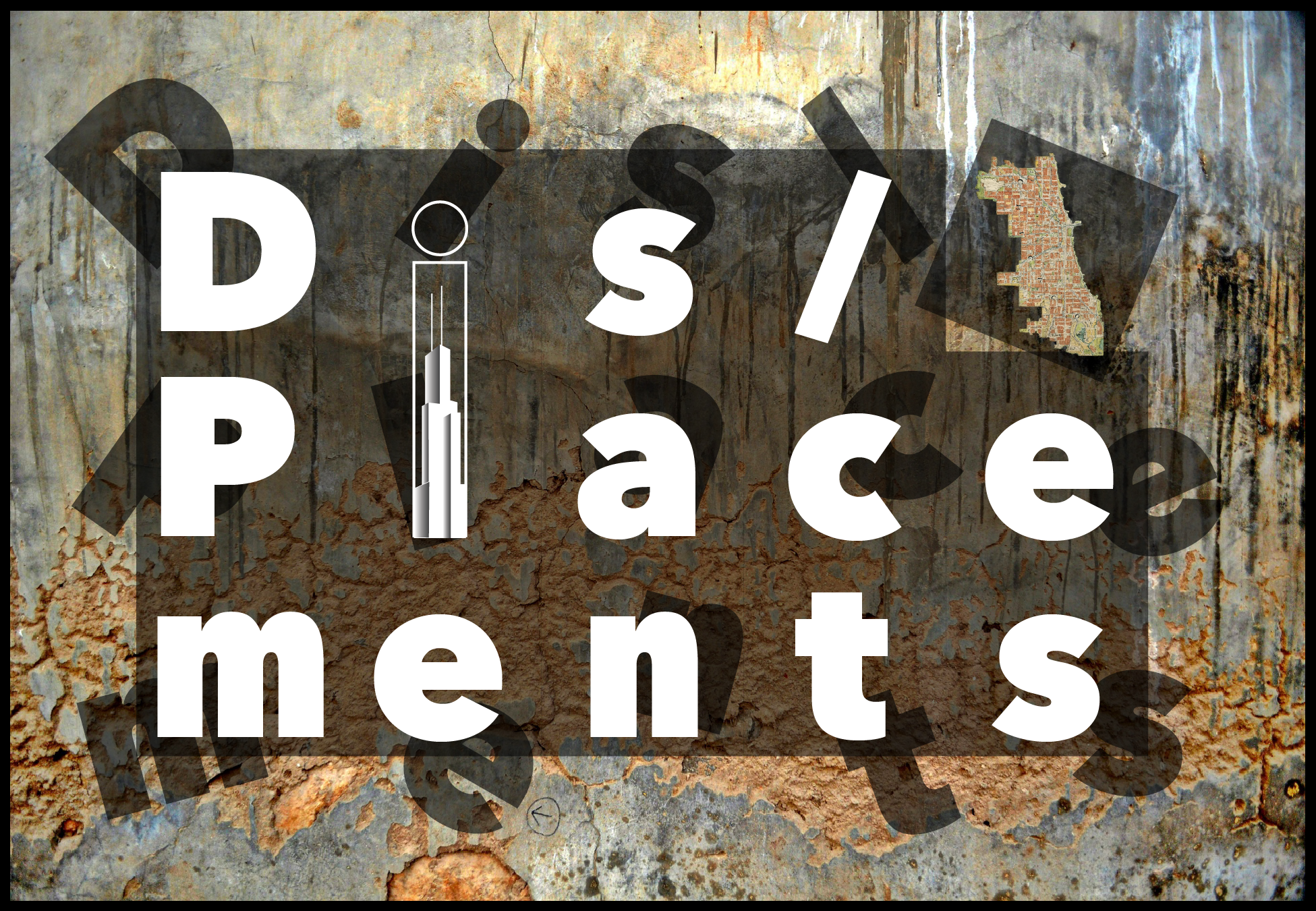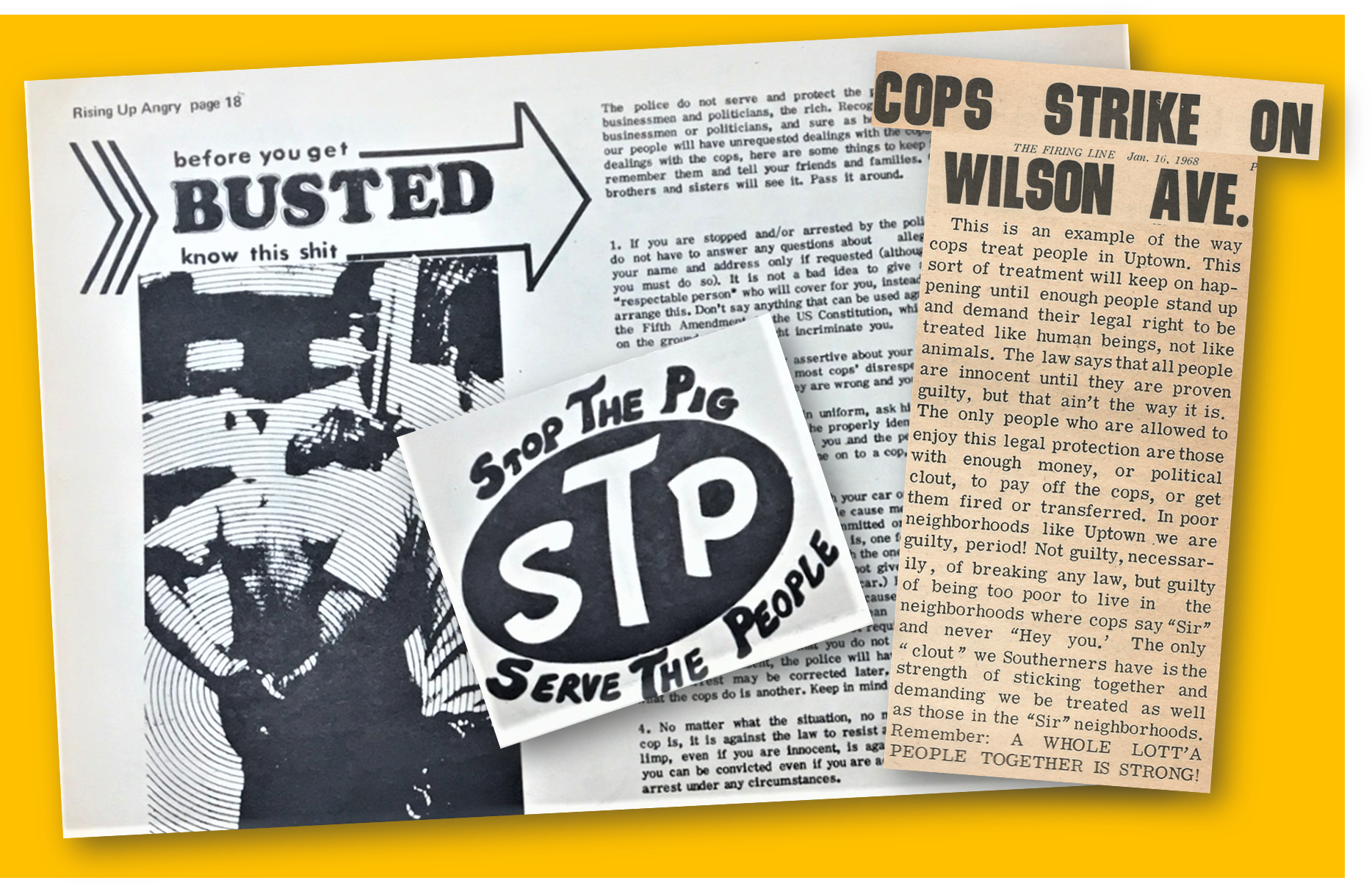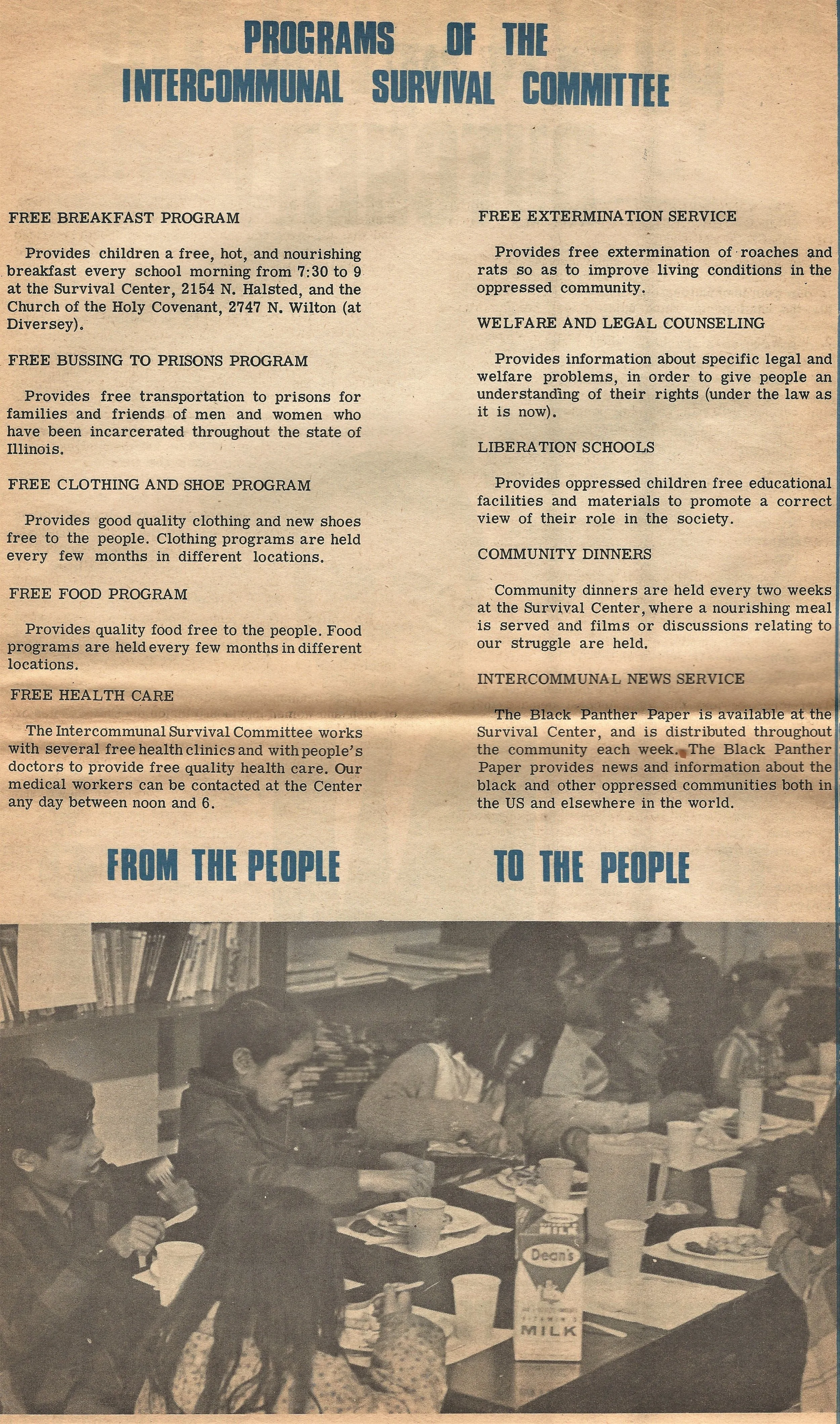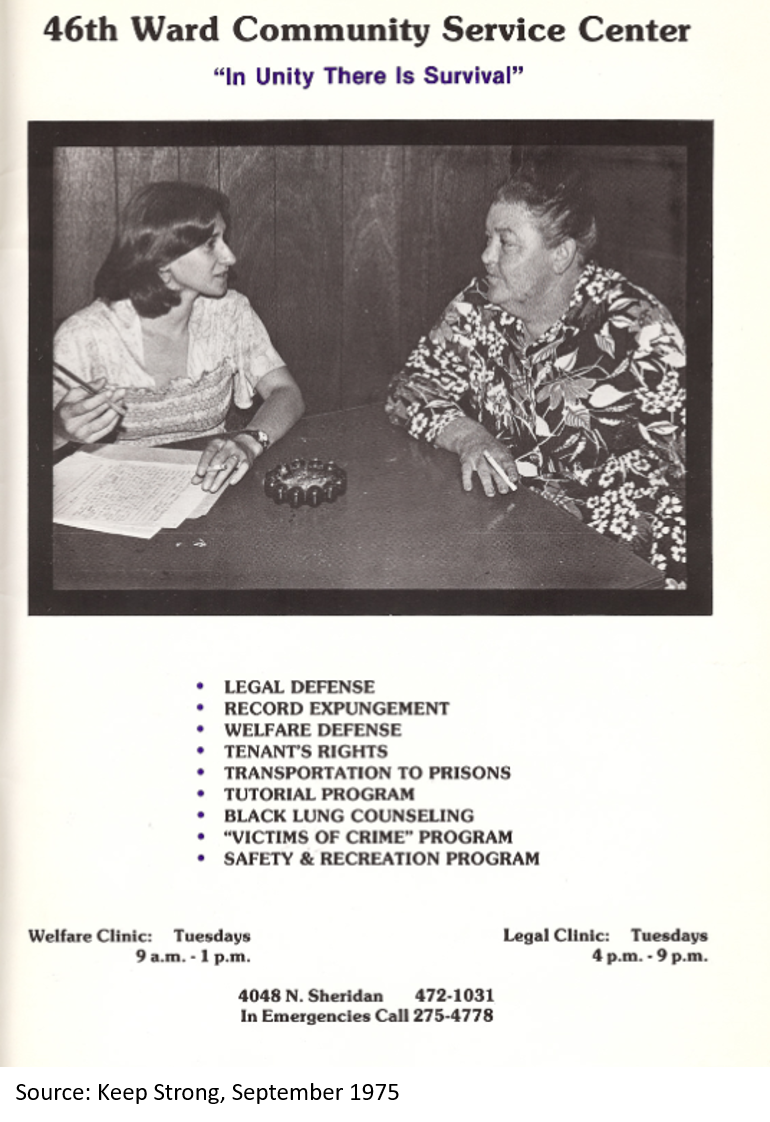Revolutionary Grease: The Rainbow Coalition
Revolutionary Grease: The rainbow coalition
Site #5 description…
This site was the office of the Young Patriots Organization, a gang of young white Southern migrants who began to participate in anti-racist, multiracial politics.
Addressing Police Brutality
The issue of police brutality in poor communities of color is not a new concern. Uptowners have been organizing against such violence for decades. The story of the multiracial Original Rainbow Coalition in Uptown is one such organizing platform. Among other issues, this coalition also tells the story of how police brutality became a crucial issue for radical poor people’s politics. Relatedly, community newsletters in Uptown often called out police violence as the repression of poor people by a state that aimed to protect elite white interests. They charged that it was easier to blame crime, racial violence, and dilapidated infrastructure on poor communities rather than examining the state’s failure in attending to poor citizens’ needs.
Unchecked acts of violence and exploitation by police were at an all-time high in gentrifying low-income neighborhoods. Community newsletters regularly reported on such acts, brought attention to the systemic nature of this violence, and aimed at raising legal awareness. "Pig" was a term commonly used for police and corrupt politicians, likely in reference to the pigs who represented the corrupt and elitist political order in George Orwell's well-known political satire, Animal Farm.
Sources: Rising Up Angry, The Firing Line (community newsletters, 1960s-80s).
Community newsletters regularly provided corrective reportage on poor people's issues, highlighting police brutality. Keep Strong covered a grand jury verdict that clearly found a pattern of police violence and surveillance, and in the case of the Black Panthers in Illinois, even assassination of persons and groups critical of the Daley administration.
Source: Keep Strong, vol. 1 no. 5, 1975.
This excerpt detailing a 1972 report on police brutality is highly reminiscent of recent cases of police violence, such as the killing of Breonna Taylor.
Source: Rising Up Angry, vol. 3 no. 17, 1972.
Youth gangs were often the main object of police surveillance and random acts of police violence. Gangs continue to be central in popular narratives that justify police violence - through ideas of poor people of color as inherently prone to criminal activity. The Original Rainbow Coalition was a multiracial group of politically aware youth gangs that fought back, raised awareness about systemic injustice, and became organizers for their communities.
Revolutionizing Gangs
In 1968, Fred Hampton, the young leader of the growing Illinois Chapter of the Black Panther Party heard of a group of young "hillbillies" on the northside of Chicago, the Young Patriots Organization (YPO), who were speaking out against racism and police brutality. Section leader Bobby Lee was dispatched to Uptown to offer allyship to the YPO.
In JOIN's story, we saw how the Uptown Goodfellows, a gang of Southern white youth, became the Young Patriots Organization. The Goodfellows played a major role in JOIN's attempts to unify the Southern white community to fight against the system, but without endorsing the racial attitudes that informed Southern pride.
Bobby Lee's aim was to forge an interracial alliance in Uptown between the YPO and the Young Lords Organization, a similarly politically-aware gang of young Puerto Rican Americans, led by José "Cha Cha" Jiménez. The Puerto Rican community of Lincoln Park, a rapidly gentrifying neighborhood, was slowly being pushed into Uptown. Ordinarily, this would lead to gang turf wars.
While a 1970 Chicago Sun-Times article interprets gang clashes as "racial violence," the YPO's poster tells the community to see this violence in a new light, and to unite against the system. Courtesy (left): Wisconsin Historical Society.
As young men of color from poor communities themselves, the members of the BPP, YLO, and YPO knew that gangs were a structural result of poverty, lack of opportunity, and most importantly, the tendency for young men in poor communities to be subject to constant police surveillance and brutality. Gangs formed as solutions to these conditions, not problems. For change to happen, gangs had to direct their anger at the system rather than each other, and they had to become representatives for their communities.
YLO leader Cha Cha's views on youth gangs centered the failures of the government in providing opportunities for young people of low income. Source: Keep Strong (ISC newsletter), 1975. Courtesy: Helen Shiller.
The Original Rainbow Coalition: All Power to the People
The Original Rainbow Coalition's aim was a poor people’s movement that would enable different ethnic communities to work with each other around common interests, even as they learned to take pride in their own identity.
The image of the raised fist as symbolizing revolution is common today, and this image became popularized in the 1960s. Source: Rising Up Angry, 1970. Courtesy: University of Illinois Special Collections.
As a result, drawing from the original program of community survival pioneered by the founders of the BPP in California, the YPO, YLO, and the BPP focused on projects within their own communities, and were joined by other groups such as Rising Up Angry. They spared no opportunity to publicly support and offer protection to one another and to talk about the need to resist and speak out against racism.
The YPO opened a free health clinic for Uptowners, in addition to running a free breakfast program. They also helped push for community control of police.
Reports and photographs of YPO programs. Sources (clockwise from top left): Rising Up Angry, vol.1 no. 7, 1970; Paul Sequeira (Getty Images) 1969; Rising Up Angry vol. 4 no. 1, 1972; Lerner Newspapers (courtesy Wisconsin Historical Society).
The YLO carried out similar programs in Lincoln Park, and after its move, in Uptown.
This report in the Intercommunal Survival Committee's newsletter draws attention to the Puerto Rican community fighting gentrification in Lincoln Park, and the YLO's move to Uptown. Source: Community Control (ISC newsletter), April 1974. Inset: YLO logo.
The End of the Coalition and Its Afterlife
This extraordinary upsurge in activity, however, was brutally cut short by FBI and local police action, extending so far as to plant informants in these organizations to sabotage their operations. In December 1969, Fred Hampton and Mark Clark, another Black Panther member, were assassinated in the middle of the night, as they slept in their apartment, by a team of state police that acted on the basis of an FBI tip. Soon after, even though the Original Rainbow Coalition expanded to New York city and other areas, the movement fizzled out as incessant legal troubles, police raids, mutual suspicion, and the general pressures of surveillance forced many of its most active members out of activism.
In Uptown, however, the Original Rainbow Coalition's vision was carried forward by Cha Cha Jiménez in alliance with the Intercommunal Survival Committee, a group of radical white students who took up the Black Panther Party's call for white radicals to organize white people towards an antiracist revolution of the poor and working class.
The ISC's programs followed the Original Rainbow Coalition model, offering free breakfasts for children, free food for families, legal counseling, prison busing, voter registration drives, and so on. Source: Unity (ISC newsletter), 1973. Courtesy: Helen Shiller Personal Archives.
In 1975, José “Cha Cha” Jimenez ran for Alderman of the 46th ward. The ISC helped him drive a remarkable, historic campaign that brought the community together and led to the setup of the 46th Ward Community Service Center, through which ISC began to expand its programs and services for the poor.
The community center's services greatly expanded over the next couple of years, and it led to the setup of separate and historic organizations like the Chicago Area Black Lung Association and the Uptown People's Law Center.
Copyright ©2018 Dis/Placements Project













